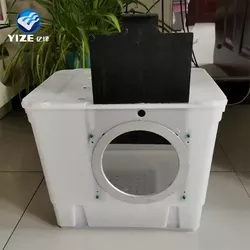broiler cage
Dec . 11, 2024 20:07 Back to list
broiler cage
The Impacts of Broiler Cages on Poultry Farming
In the world of poultry farming, the term broiler cages often evokes a mixture of debate and concern. Broiler chickens, bred specifically for meat production, have seen significant advancements in breeding and husbandry techniques over the years. However, the use of cages to house these birds has sparked discussions regarding animal welfare, productivity, and sustainability.
Broiler cages are typically used in industrial farming settings, where large numbers of chickens are raised in confined spaces. This system allows farmers to optimize space and streamline the feeding and health management of the birds. Advocates for cage systems argue that they make it easier to monitor health, reduce disease transmission, and improve feed efficiency. Moreover, controlled environments can lead to better growth rates and lower mortality, which are crucial in meeting the rising demands for poultry products globally.
However, the drawbacks of using broiler cages cannot be overlooked. One of the primary concerns relates to animal welfare. Critics of cage systems argue that confinement restricts the natural behaviors of chickens, including movement, foraging, and social interactions. Studies have shown that these restrictions can lead to increased stress and aggression among birds, negatively affecting their overall well-being. The ethics of keeping animals in such confined conditions have prompted calls for alternative housing systems that allow for greater freedom and better quality of life.
broiler cage

Another significant concern associated with broiler cages is the potential for environmental impact. Intensive poultry farming often leads to large concentrations of waste, which can result in environmental degradation if not managed properly. Nutrient runoff from these operations can contaminate nearby water sources, leading to issues such as algal blooms that harm aquatic ecosystems. Furthermore, the reliance on antibiotics in confined systems, aimed at preventing disease in overcrowded conditions, raises concerns about antibiotic resistance, which poses a significant threat to public health.
In response to these issues, there has been a growing movement toward more humane and sustainable poultry farming practices. Alternatives to broiler cages, such as free-range or pasture-based systems, allow chickens more space to roam and engage in natural behaviors. These systems not only aim to improve animal welfare but can also enhance the nutritional value of the meat produced and reduce the environmental footprint of poultry farming. Consumers are increasingly becoming aware of the methods used in food production and are starting to prioritize welfare-oriented products. This shift in consumer preference encourages farmers to adopt more ethical practices and invest in sustainable farming solutions.
Furthermore, technological advancements are paving the way for improved poultry management systems that can optimize production while prioritizing animal welfare. Smart farming technologies, such as automated feeding systems, climate control, and health monitoring, can enhance the efficiency of non-caged systems, ensuring that birds receive the care they need while also maximizing productivity. Research in genetics and nutrition continues to evolve, offering innovative solutions to maintain high growth rates and feed conversion ratios without relying on traditional confinement methods.
In conclusion, while broiler cages have played a significant role in the poultry industry’s ability to meet soaring demand, the ethical, environmental, and health implications of this practice are leading to a re-evaluation of methods used in poultry farming. The future of broiler production may very well hinge on a balance between productivity and ethical considerations, driving the industry to innovate and adapt in a way that ensures both animal welfare and sustainable practices. As consumers demand change, the poultry industry must respond, paving the way for a more responsible approach to chicken farming that benefits all stakeholders involved.
-
Hot Sale 24 & 18 Door Rabbit Cages - Premium Breeding Solutions
NewsJul.25,2025
-
Automatic Feeding Line System Pan Feeder Nipple Drinker - Anping County Yize Metal Products Co., Ltd.
NewsJul.21,2025
-
Automatic Feeding Line System Pan Feeder Nipple Drinker - Anping County Yize Metal Products Co., Ltd.
NewsJul.21,2025
-
Automatic Feeding Line System - Anping Yize | Precision & Nipple
NewsJul.21,2025
-
Automatic Feeding Line System - Anping Yize | Precision & Nipple
NewsJul.21,2025
-
Automatic Feeding Line System-Anping County Yize Metal Products Co., Ltd.|Efficient Feed Distribution&Customized Animal Farming Solutions
NewsJul.21,2025






